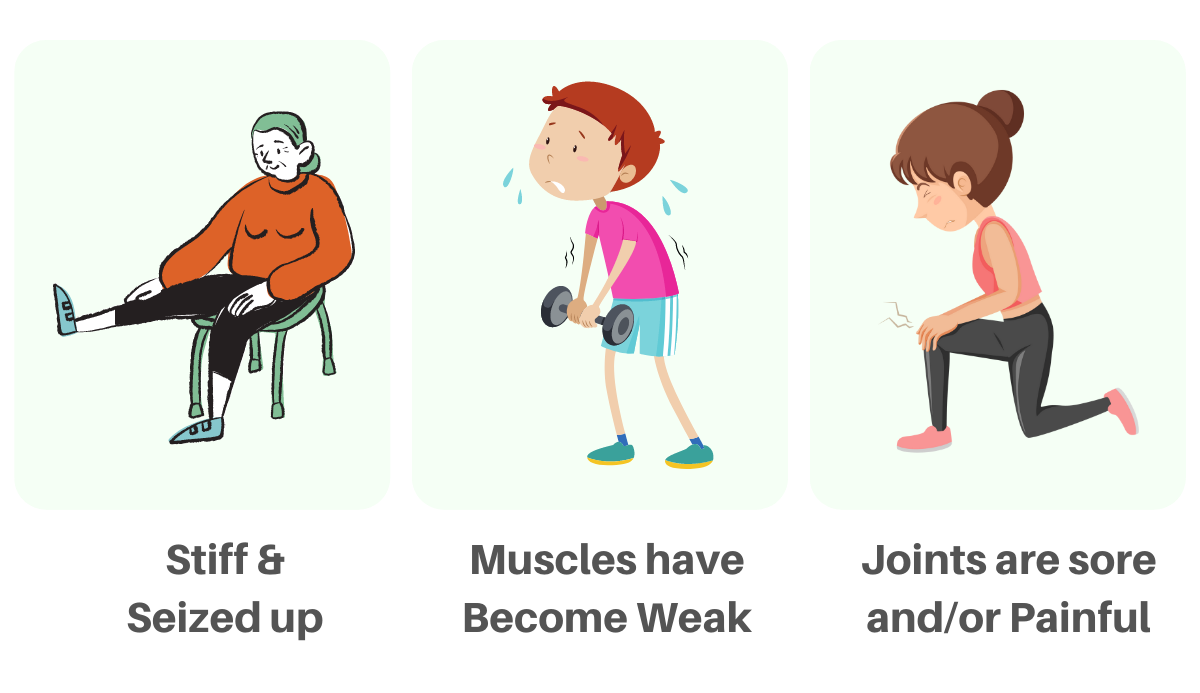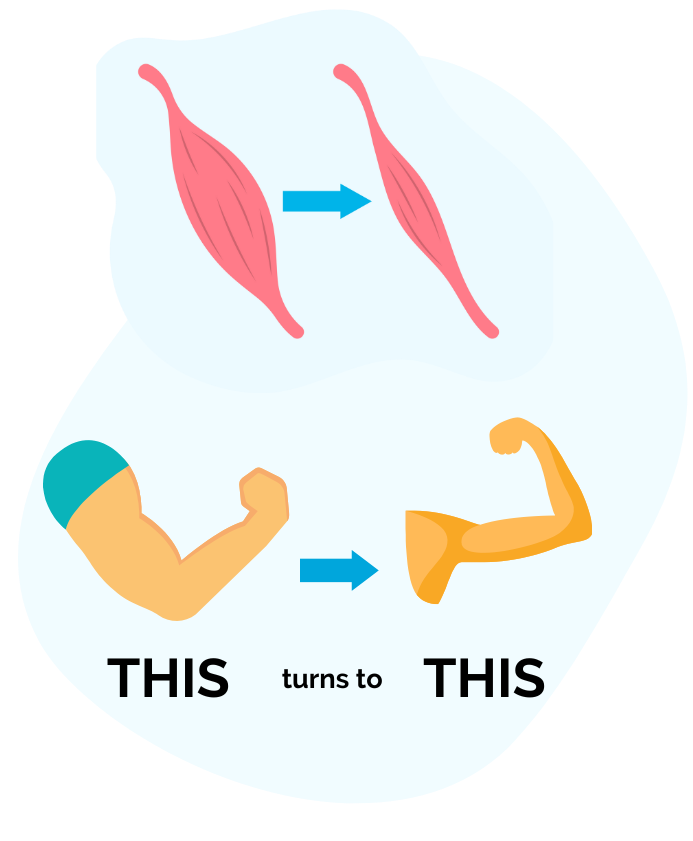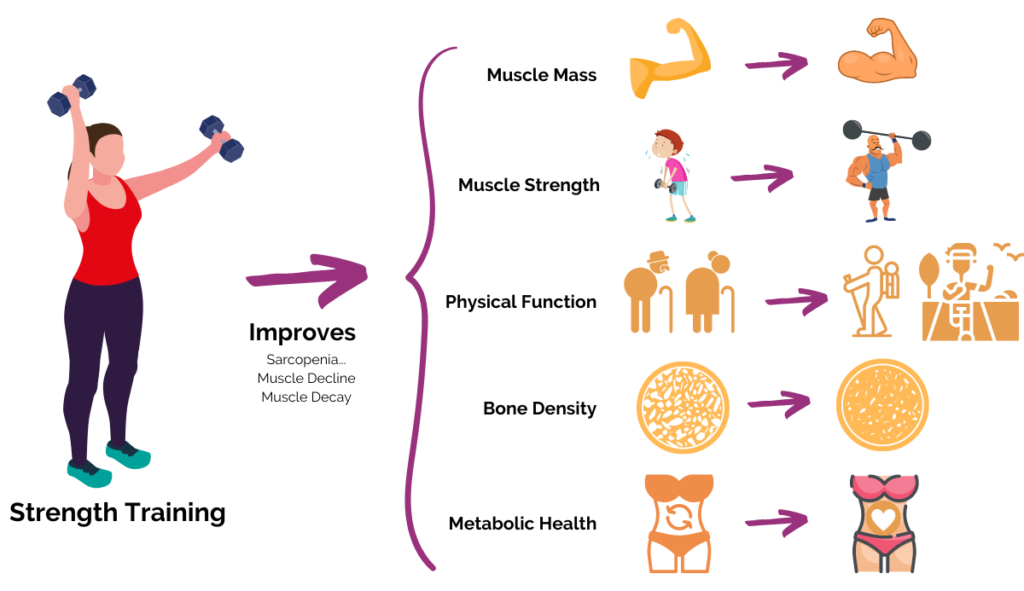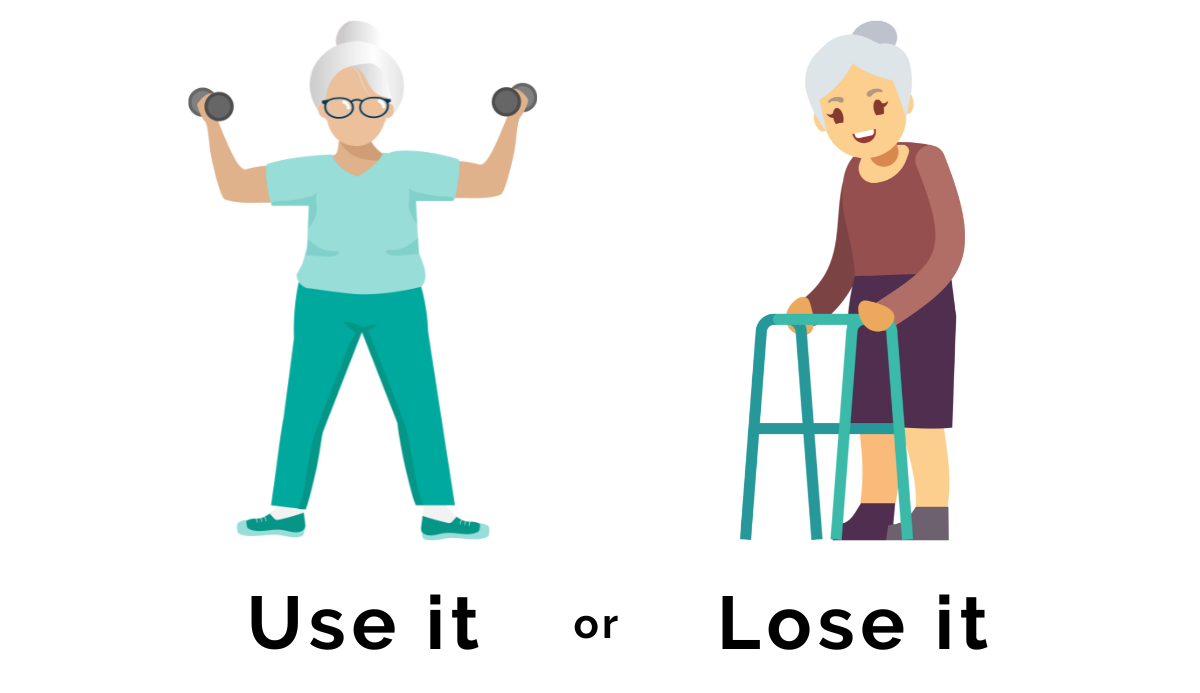Strength Training for Women over 50: Empowering Workouts:

Strength training, also known as resistance training, involves exercises that improve muscular strength and endurance. It includes activities like lifting weights, using resistance bands, and performing bodyweight exercises. For women over 50, strength training is not just about building muscles; it’s about enhancing overall health and well-being. As women age, they face unique health challenges such as decreased bone density, reduced muscle mass, and slower metabolism. Strength training can address these issues, making it a crucial component of a healthy lifestyle for women over 50.
Table of Contents
This article aims to empower women over 50 by providing comprehensive information on strength training. From understanding its benefits to debunking common myths and providing practical tips, this guide will help women embrace strength training as a lifelong fitness journey.
Over 50 with a de-conditioned body
Clearly we’re not 30 anymore regardless of how young our thoughts may be.
Unfortunately though, most of us have succumbed to the 20th century scourge of inactivity IE. no regular movement in our daily work and/or exercise which would typically be under load, ie. with a weight.
Additionally, sitting all day at work, then at home, has become the norm.
So now you’re dealing with a body that’s:

Plus, your mobility has decreased, resulting in everyday activities becoming increasingly difficult, where you’re now searching for alternate ways to do them.
There is however, one more issue we need to address.
Whether it’s knowingly or unknowingly, your body has secretly been succumbing to another scourge. This one we ALL face, your level of past activity however, will determine how far progressed this is.
And that’s,
Sarcopenia… muscle decline or muscle decay

This is an age-related condition that results in the loss of muscle mass, strength, and function.
It generally starts in our 30s, with a gradual decline in muscle and strength, reaching a deterioration rate of 1-2% through our 50’s, then increasing up to 3% in our senior years.
This is a huge topic, not greatly talked about in health and wellness circles that we’ll cover in detail in a future post.
However, there is a link between sarcopenia and the inactivity we discussed above.
Scarily though, the combination of the two, inactivity for decades from our 30’s and aging sarcopenia, creates the perfect storm leading into our 50’s, where we’ll either succumb or succeed.
Benefits of Strength Training for Women over 50
Physical Health Benefits

Increased Muscle Mass: As women age, muscle mass naturally decreases, leading to a slower metabolism and increased body fat. Strength training helps to counteract this muscle loss, maintaining and even building muscle mass which, in turn, boosts metabolic rate.
Improved Bone Density: Osteoporosis is a common concern for older women. Strength training is one of the most effective ways to increase bone density and reduce the risk of fractures and osteoporosis.
Enhanced Metabolic Rate: With an increased muscle mass, the body burns more calories at rest, which helps in weight management and reduces the risk of metabolic disorders such as diabetes.
Mental Health Benefits
Stress Reduction: Exercise, including strength training, releases endorphins, which are natural mood lifters. This helps in reducing stress and combating anxiety and depression.
Improved Sleep: Regular strength training can help regulate sleep patterns, leading to better quality sleep, which is essential for overall health.
Enhanced Cognitive Function: Studies have shown that regular physical activity, including strength training, can improve cognitive functions such as memory and attention, and may even reduce the risk of cognitive decline and dementia.
Emotional and Social Benefits
Boosted Self-Esteem: Achieving strength training goals can lead to a significant boost in self-confidence and self-esteem.
Social Engagement Opportunities: Joining a gym or a fitness class provides opportunities for social interaction, which is beneficial for emotional well-being.
Why is strength training consistency important?
The simple answer is…

Sarcopenia/Muscle Decay, particularly, takes no prisoners.
We all desire a strong active body that works, but, as we move through our 50’s, 60’s, 70’s and beyond, let me lay out a few consequences of not habitually addressing these issues, through the primary solution of consistent strength training.
Common Myths and Misconceptions
Myth: Strength Training Makes Women Bulky: Many women fear that lifting weights will make them bulky. However, due to lower levels of testosterone, women do not gain muscle mass in the same way men do. Strength training will tone and strengthen muscles without adding bulk.
Myth: It’s Too Dangerous for Older Women: While it’s true that older women need to be cautious, strength training can be safe and effective when done correctly. Starting with lighter weights and focusing on proper form can mitigate the risk of injury.
Myth: Strength Training is Only for the Young: Strength training is beneficial for individuals of all ages. In fact, older adults can see significant improvements in strength, balance, and overall health by incorporating strength training into their routine.
Getting Started with Strength Training
Initial Assessments and Consultations: Before starting a strength training program, it’s important to consult with a healthcare provider or a fitness professional. They can assess your current fitness level, identify any potential health issues, and help design a personalized workout plan.
Setting Realistic Goals: Setting achievable and realistic goals is crucial. Start with small, manageable targets and gradually increase the intensity and duration of your workouts as you progress.
Choosing the Right Environment: Whether you prefer working out at home, in a gym, or outdoors, choosing a comfortable and motivating environment is key to maintaining a consistent workout routine.
Basic Principles of Strength Training
Progressive Overload: This principle involves gradually increasing the weight, frequency, or number of repetitions in your strength training routine. This progressive increase forces your muscles to adapt and grow stronger over time.
Specificity: Your training should be specific to your goals. For example, if you want to improve your upper body strength, your workout should focus on exercises that target the upper body.
Rest and Recovery: Rest days are just as important as workout days. Muscles need time to recover and repair after a workout, which helps in preventing injuries and improving performance.
Types of Strength Training
Bodyweight Exercises: These exercises use your own body weight as resistance. Examples include push-ups, squats, and lunges. They are great for beginners and can be done anywhere without any equipment.
Free Weights: Using dumbbells, barbells, and kettlebells can provide a versatile and effective strength training workout. Free weights help in improving balance and coordination.
Resistance Bands: These are lightweight, portable, and can be used to add resistance to various exercises. Resistance bands are particularly useful for those who want a low-impact workout.
Machines: Weight machines are a good option for those who are new to strength training or who want to ensure proper form and technique. They can help isolate specific muscle groups and reduce the risk of injury.
Designing a Strength Training Program
Frequency of Workouts: For beginners, starting with two to three strength training sessions per week is recommended. As you become more experienced, you can increase the frequency to four to five sessions per week.
Duration and Intensity: Each workout session should last between 45 to 60 minutes, including warm-up and cool-down. The intensity should be challenging but manageable, allowing you to complete your sets and repetitions with proper form.
Balanced Training: A well-rounded strength training program should include exercises for the upper body, lower body, and core. This ensures balanced muscle development and reduces the risk of injury.
Essential Strength Training Exercises
Squats: Squats are a fundamental lower body exercise that targets the thighs, hips, and buttocks. They help improve leg strength and overall mobility.
Lunges: Lunges work the thighs, hips, and buttocks while also improving balance and coordination. They can be performed with or without weights.
Push-ups: Push-ups are a great upper body exercise that targets the chest, shoulders, and triceps. They also engage the core muscles.
Rows: Rows target the upper back, shoulders, and biceps. They can be performed with dumbbells, resistance bands, or on a machine.
Planks: Planks are an excellent core exercise that also engages the shoulders and glutes. They help improve overall core strength and stability.
Deadlifts: Deadlifts are a full-body exercise that primarily targets the lower back, glutes, and hamstrings. They are effective for building overall strength.
Safety Tips and Precautions
Proper Warm-Up and Cool-Down: Always start with a warm-up to prepare your muscles and joints for exercise. Similarly, end your workout with a cool-down to aid in recovery.
Correct Form and Technique: Focus on performing each exercise with the correct form and technique. This reduces the risk of injury and ensures you are targeting the intended muscle groups.
Listening to Your Body: Pay attention to how your body feels during and after workouts. If you experience pain or discomfort, stop the exercise and consult a fitness professional.
Nutrition and Hydration
Importance of Protein: Protein is essential for muscle repair and growth. Include a source of protein in each meal to support your strength training efforts.
Balancing Macronutrients: Ensure your diet includes a balance of carbohydrates, proteins, and fats to provide the energy needed for workouts and recovery.
Staying Hydrated: Proper hydration is crucial for optimal performance and recovery. Drink water before, during, and after your workouts.
Overcoming Challenges
Dealing with Joint Pain and Mobility Issues: Modify exercises to accommodate any joint pain or mobility issues. Consult a fitness professional for guidance on safe modifications.
Staying Motivated: Keep your workouts interesting by varying your routine and setting new goals. Joining a class or finding a workout buddy can also help keep you motivated.
Time Management: Incorporate short, effective workouts into your schedule if you have limited time. Consistency is more important than the length of individual workouts.
Tracking Progress and Setting New Goals
Keeping a Workout Journal: Track your workouts, including the exercises, sets, and repetitions. This helps in monitoring progress and staying motivated.
Using Technology: Fitness apps and wearable devices can help track your progress, set goals, and provide reminders to stay active.
Adjusting Goals Over Time: As you progress, adjust your goals to continue challenging yourself. This keeps your workouts engaging and prevents plateaus.
Success Stories and Personal Testimonials
Real-Life Examples: Hearing from women who have successfully incorporated strength training into their lives can be incredibly motivating. Look for stories and testimonials from women over 50 who have seen positive changes in their health and fitness.
Lessons Learned: Learning from others’ experiences can provide valuable insights and tips for your own strength training journey.
Expert Insights
Quotes and Advice from Fitness Professionals: Seek advice from fitness trainers and professionals who specialize in working with older adults. Their expertise can help you design a safe and effective strength training program.
Medical Perspectives: Consult with healthcare providers to understand the medical benefits of strength training and any specific considerations for your health condition.
Strength training is a powerful tool for women over 50 to enhance their physical, mental, and emotional well-being. By debunking common myths, understanding the benefits, and following a well-designed program, women can embrace strength training with confidence. Whether you’re just starting or looking to enhance your routine, remember that it’s never too late to reap the benefits of strength training. Begin your journey today and enjoy a healthier, stronger, and more empowered life.
- Also Read :
- Bodyweight Strength Training: No Equipment Needed
- Ultimate Guide to Strength Training Workouts
- What is Functional Strength Training
- 10 Yoga Poses for Neck Pain
- Beat Tech Neck with Easy Exercises
Frequently Asked Questions (FAQs):
Why is strength training important for women over 50?
Strength training is crucial for women over 50 as it helps counteract age-related muscle loss, improves bone density, boosts metabolism, and enhances overall physical and mental health.
Will strength training make me bulky?
No, strength training will not make you bulky. Women typically have lower levels of testosterone, which means they do not gain muscle mass in the same way men do. Instead, strength training will tone and strengthen your muscles.
How often should I do strength training exercises?
For beginners, it is recommended to start with two to three strength training sessions per week. As you progress, you can increase the frequency to four to five sessions per week, ensuring you allow for rest and recovery between sessions.
What type of strength training exercises should I start with?
Beginners can start with bodyweight exercises like squats, lunges, push-ups, and planks. As you become more comfortable, you can incorporate free weights, resistance bands, and machines into your routine.
